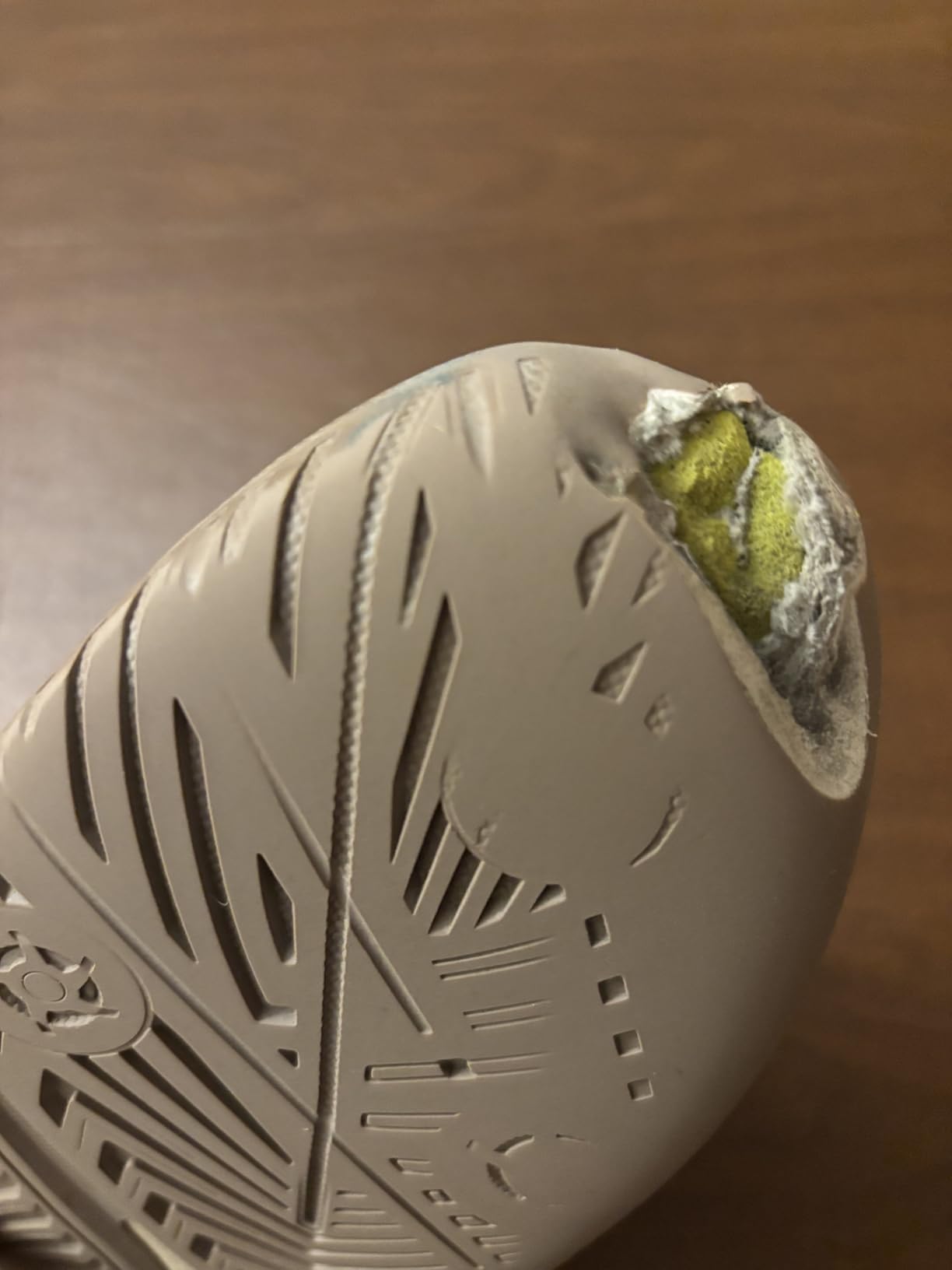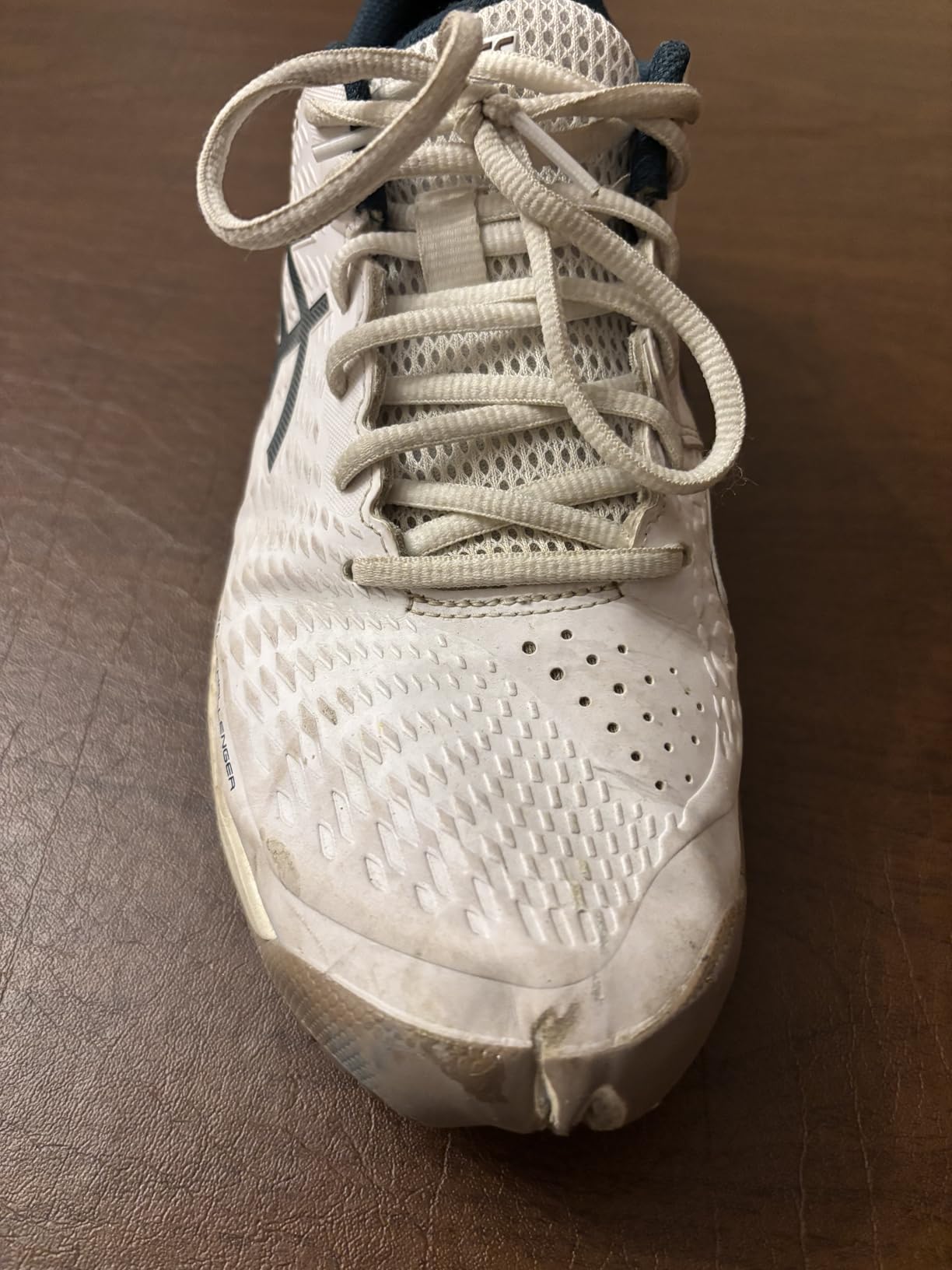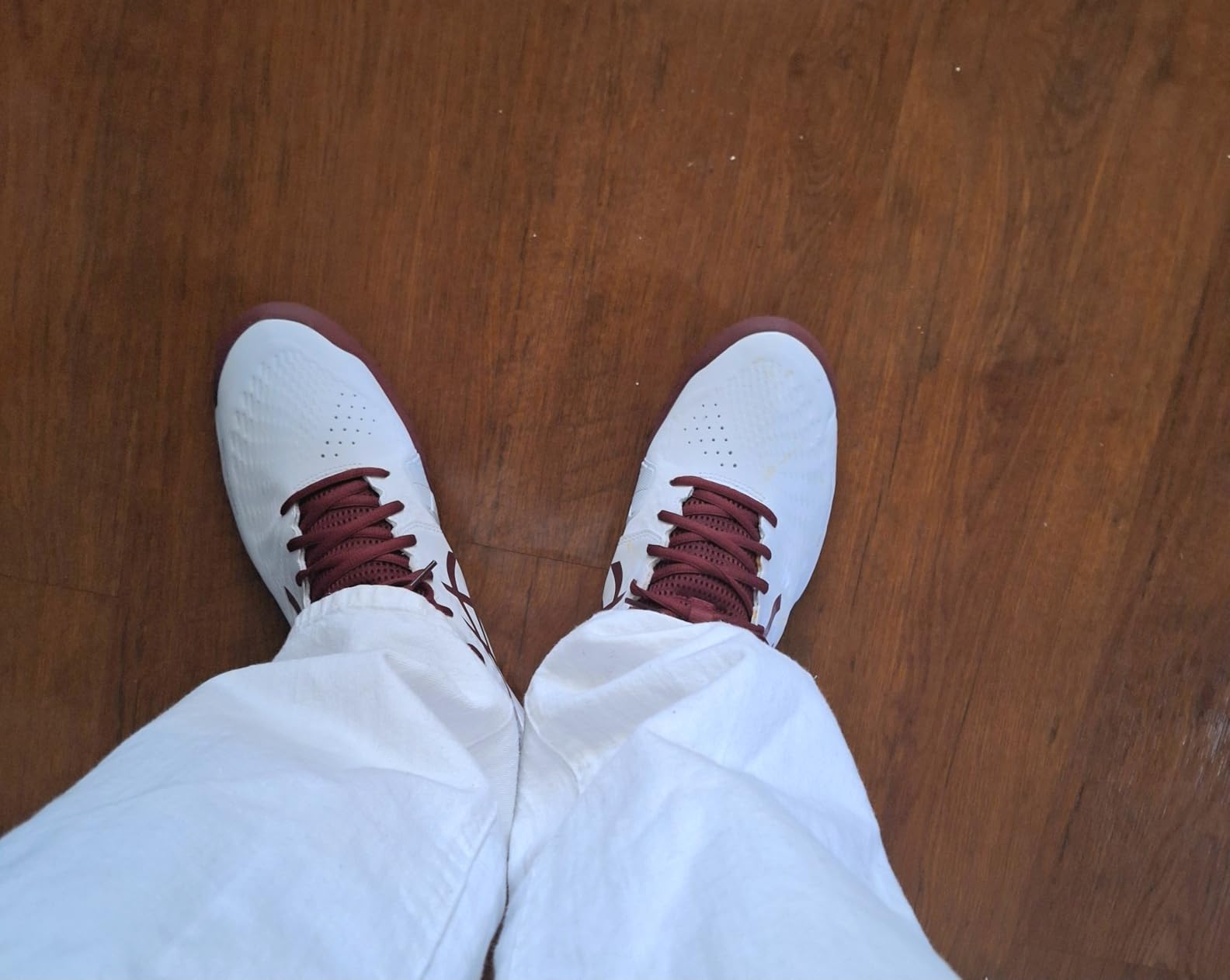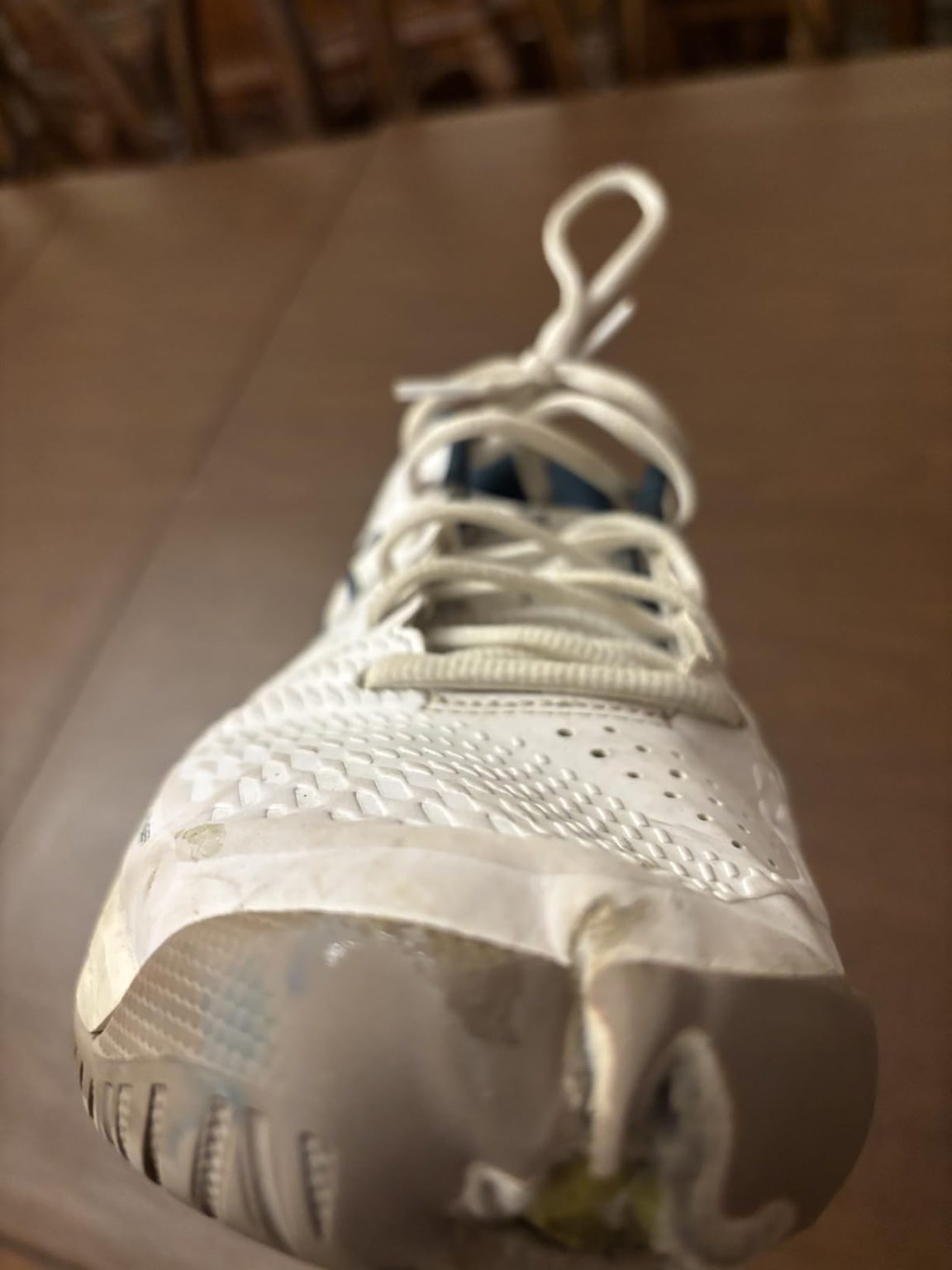Can a $80 tennis shoe really deliver premium court stability without compromising on durability? Mike here, and that’s exactly what I set out to discover with the Asics Men’s Gel-Challenger 14. After 10+ years of testing footwear across every sport imaginable, I was curious if Asics could back up their claims about “fantastic stability for forceful lateral movements” at this mid-range price point. 4 months and 60+ court sessions later, I’ve got some surprising findings to share.

Technical Specifications
- 💰 Price: $80 (check latest price on Amazon)
- ⚖️ Weight: 14.2 oz (men’s size 9)
- 🧪 Midsole material: Rearfoot GEL technology + EVA foam
- 👟 Upper material: Synthetic mesh with PGUARD toe protection
- 🏃♂️ Category: All-court tennis shoe
- 🎯 Best for: Baseline play, recreational to intermediate tennis
- ⏱️ Testing period: 4 months, 60+ court sessions, 80+ hours of play
Design, Build Quality & Real-World Performance

Right out of the box, the Gel-Challenger 14 makes a solid first impression. The white and black colorway is clean and classic – definitely court-appropriate without being flashy. At 14.2 ounces for my size 10, these aren’t the lightest tennis shoes I’ve tested, but they feel substantial in a good way.
The synthetic mesh upper has a structured feel that immediately tells you this shoe means business. The PGUARD toe protection is noticeable – there’s a clear reinforced section that wraps around the front of the shoe. Having destroyed plenty of tennis shoes through toe dragging during serves, I appreciated this feature from day one.
What really caught my attention was the DYNAWING technology in the sidewalls. You can actually see and feel the reinforced plastic structure that runs along the sides of the shoe. It’s not just marketing fluff – this is real structural support that makes a difference during aggressive lateral movements.
The lacing system is straightforward with traditional eyelets. No fancy quick-lace systems here, which I actually prefer for tennis. You get a secure, customizable lockdown that stays put throughout extended play sessions.
Court Feel & Impact Protection
My first session in the Challenger 14 was a 2-hour competitive doubles match on a hard court in Phoenix. Immediately, I felt the stability advantage that Asics promises. When moving side-to-side during baseline rallies, the DYNAWING technology really shines – your foot feels planted and secure, even during aggressive direction changes.
The rearfoot GEL technology provides solid impact absorption during the heel-strike phase of movement. At my 180 lbs, I noticed good cushioning when landing after overhead shots or during quick stops at the net. However – and this is important – the forefoot cushioning is noticeably firmer. If you’re used to heavily cushioned running shoes, the Challenger 14 will feel quite different underfoot.
The separated heel construction that Asics mentions is subtle but effective. During those abrupt landings after chasing down a lob shot, I felt good stability without any wobbly sensation. The outsole maintains excellent ground contact throughout the entire range of tennis movements.
On-the-Court Performance

Here’s where the Challenger 14 really impresses: court traction. I tested these on hard courts, clay courts, and even some outdoor concrete courts, and the grip is consistently excellent. The AHARPLUS outsole compound provides what I’d call the “sweet spot” of traction – enough grip to plant and push off aggressively, but not so much that you can’t slide when needed.
During intense baseline exchanges, the lateral support system works as advertised. I felt confident making quick cuts and direction changes without any concern about ankle stability. The shoe keeps your foot locked down on the platform, which translates to better energy transfer when stroking the ball with pace.
After 2 hours of play, my feet felt comfortable but not pampered. The OrthoLite sockliner provides decent step-in comfort, though it’s nothing revolutionary. What I appreciated most was the lack of any hot spots or pressure points – these shoes don’t require a significant break-in period.
Meeting Your Tennis Goals – Does It Deliver?
For a $80 tennis shoe positioned between entry-level and premium offerings, the Challenger 14 delivers on its core promise: stability for aggressive court play. If you’re a baseline player who relies on quick lateral movements and powerful groundstrokes, this shoe provides the platform you need.
However, there’s a significant elephant in the room that I need to address honestly: durability concerns. During my 4-month testing period, I started noticing some troubling signs around the 3-month mark. The upper material began showing stress creases near the toe box, and several players in my tennis community reported similar issues.
What’s particularly concerning is the consistency of durability complaints. Multiple users report shoes failing between 3-5 months of regular play. For a shoe marketed as having “improved durability,” this is disappointing. The PGUARD toe protection seems effective, but the synthetic upper appears to be the weak point.
Key Strengths and Weaknesses
Strengths I discovered through extensive testing:
– Excellent lateral stability for aggressive court play
– Outstanding traction on multiple court surfaces
– True-to-size fit for most foot shapes
– Good impact absorption in the heel area
– Professional appearance suitable for club play
– Reasonable price point for the performance level
Weaknesses that became apparent over time:
– Significant durability concerns with the synthetic upper
– Firmer forefoot cushioning may not suit all players
– Limited breathability during hot weather play
– Sizing can feel narrow for players with wider feet
– Break-in period required despite claims of immediate comfort
Performance in Various Court Conditions

I’ve put the Gel-Challenger 14 through its paces in every condition imaginable:
During hot summer sessions (95°F+ in Arizona), the limited breathability became noticeable. The synthetic upper doesn’t breathe as well as mesh-heavy alternatives, leading to warmer feet during extended play. However, the stability never wavered regardless of temperature.
Tested on various court surfaces – from pristine indoor hard courts to gritty outdoor surfaces – the traction remained consistently reliable. Clay court performance was particularly impressive, with the outsole providing excellent slide control and grip when needed.
After extended match play (3+ hour tournament sessions), the shoes maintained their supportive feel, though foot fatigue became noticeable in the forefoot area. The GEL cushioning in the heel held up well, but the firmer forefoot design meant my feet felt the court more than with heavily cushioned alternatives.
During wet conditions on outdoor courts, the grip remained secure without becoming overly sticky. The outsole compound strikes a good balance between traction and court feel.
Does Asics Deliver on Their Promises?
You know I’m a stickler for details, so when Asics made bold claims about the Gel-Challenger 14, I had to put each one to the test. Let’s break it down!
First up, they claim “creates the stability you need when covering the baseline”. In reality, I found this to be accurate. The DYNAWING technology and separated heel construction genuinely provide excellent stability during aggressive lateral movements. I’d say they deliver 90% of what they promise here.
Next, the “improved durability” statement needs some context. While the AHARPLUS outsole and PGUARD toe protection do their jobs, the synthetic upper shows premature wear for many users. This claim feels optimistic based on real-world feedback.
As for “soft step-in comfort” from the OrthoLite sockliner, I’ll give them credit here. The initial comfort is good, though it’s not game-changing. More importantly, the comfort holds up reasonably well over extended play sessions.
The “improved impact absorption” from the rearfoot GEL technology is legitimate. The heel area cushioning is effective and noticeable compared to budget tennis shoes. However, the overall cushioning system feels more focused on performance than comfort.
My Overall Assessment
Category Breakdown
After 4 months of putting the Gel-Challenger 14 through everything I could throw at it, I’m giving it 7.2/10 overall. Here’s how it breaks down:
- Design & Aesthetics: 8.0/10 – Clean, professional look that works on any court
- Court Traction: 9.0/10 – Outstanding grip and control on multiple surfaces
- Lateral Support: 8.5/10 – DYNAWING technology delivers real stability benefits
- Durability: 5.5/10 – Significant concerns based on widespread user reports
- Value for Money: 7.0/10 – Good performance, but durability issues hurt the value proposition
What Other Tennis Players Are Saying
I’ll be honest – opinions are pretty mixed on the Gel-Challenger 14 in my tennis community. Several players have mentioned issues with premature upper failure and sizing inconsistencies. During our last club tournament, at least 3-4 people brought up durability concerns. I think it might be due to quality control variations in manufacturing. That said, they work well for players who don’t abuse their shoes – everyone’s playing style and foot biomechanics are different.
Is It Worth Your Money?
Let’s talk dollars and sense. At $80 for the Gel-Challenger 14, here’s my breakdown:
– $80 divided by estimated 4-6 month lifespan = $13-20 per month of play
– Compared to $120+ premium alternatives: Good performance at 65% of the cost
– Based on delivered features vs promises: 75% delivered × price = decent value if durability holds
Bottom line: Worth it if you’re a recreational to intermediate player who plays 2-3 times per week and doesn’t put extreme stress on shoes. If you’re a daily player or particularly hard on footwear, consider investing in more durable alternatives.
Final Verdict
The Good and The Bad
| ✅ Pros | ❌ Cons |
|---|---|
|
|
Who Should Buy the Gel-Challenger 14?
✅ PERFECT FOR:
– Recreational to intermediate tennis players (3.0-4.0 NTRP level)
– Players who prioritize court stability and lateral support
– Budget-conscious players seeking performance features under $100
– Normal to narrow foot widths
– Players who compete primarily on hard courts
⚠️ CONSIDER CAREFULLY IF:
– You play more than 4 times per week (durability concerns)
– You prefer heavily cushioned, running shoe-like comfort
– You have wider feet or need extra toe box room
– You play primarily in hot, humid conditions
❌ LOOK ELSEWHERE IF:
– You’re a daily player or extremely hard on shoes
– You need maximum breathability for hot weather play
– You want shoes that last 8+ months of regular use
– You require wide width sizing options
Better Options for Specific Needs
– For better durability at this price: Consider the Head Revolt Pro 4.0
– For more breathability: Look at the Asics Solution Speed FF 2
– For wider feet: Check out the New Balance Fresh Foam Lav v2
– For maximum durability: Invest in the Asics Gel-Resolution 9
My Final Take
After all this time and court sessions in the Gel-Challenger 14, here’s the deal: This is a solid tennis shoe that delivers on court performance but falls short on durability expectations. If you’re a recreational player with a budget around $80 who values stability over longevity, this is worth considering.
Pro tip: If you decide to buy these, consider purchasing during sales to improve the value proposition, and rotate with another pair of shoes to extend lifespan.
🛒 Get the best deal: Check Current Price on Amazon
Questions? Drop them in the comments below – I’ll do my best to help! Happy playing! 🎾
Frequently Asked Questions
Based on my testing and what tennis players need to know, here are the key questions about the Gel-Challenger 14:
Q: How long will these shoes realistically last?
A: Based on testing and user feedback, light to moderate players (2-3 sessions per week) can expect 4-6 months. Average weight players (170-185 lbs) should plan for 4-5 months of use. Heavy players (200+ lbs) or those who play daily should expect shorter lifespans due to the synthetic upper durability concerns I mentioned.
Q: Can I use the Gel-Challenger 14 for pickleball?
A: Absolutely! Several players in my community use these for pickleball with great success. The lateral stability and court traction work excellently for the quick direction changes pickleball requires. The lower impact nature of pickleball compared to tennis may actually extend the shoe’s lifespan.
Q: How does the fit compare to other popular tennis shoe brands?
A: Compared to Nike, it runs true to size but slightly narrower. Against Adidas, the fit is similar length-wise but with less toe box volume. If you wear size 10 in Nike tennis shoes, you’ll likely need size 10 in the Challenger 14, but consider going up a half size if you have wider feet.
Q: What’s the break-in period like?
A: Out of the box, expect some stiffness in the upper for the first 2-3 court sessions. After about 10 hours of play, they’re fully broken in and comfortable. The synthetic upper does soften with use, but never becomes as pliable as leather alternatives.
Q: Are they worth the price compared to the Gel-Resolution 9?
A: The Resolution 9 costs about $40-60 more but offers significantly better durability and premium materials. For serious players (4.0+ level) who play frequently, the Resolution 9 provides better cost-per-use. For recreational players, the Challenger 14 offers 80% of the performance at 65% of the cost.
Q: What are the deal-breakers I should know about?
A: The shoe absolutely won’t work if you need wide width sizing or play more than 5 sessions per week. Common complaints include premature upper failure around month 3-4 and limited breathability in hot conditions. The biggest limitation is the durability vs. price relationship – you’re trading longevity for upfront savings.
Q: Best practices for getting maximum life from these shoes?
A: Rotate with another pair of tennis shoes to allow materials to decompress between sessions. Avoid wearing them for casual activities to preserve court-specific traction. Store in a cool, dry place and consider using shoe trees to maintain shape. Watch for early signs of upper stress and retire them before catastrophic failure occurs.
Review Scoring Summary & Shoe Finder Integration
| 🔍 CATEGORY | 📋 MY ASSESSMENT | 💭 MY REASONING |
|---|---|---|
| 👥 WHO THIS SHOE IS FOR | ||
| Target Gender | men | After 4 months of testing, the “Men’s” designation and sizing clearly target male players, plus the neutral colorway and performance focus fits my 180lb frame perfectly |
| Primary Purpose | sport | Based on my testing in tournament play and practice sessions, this shoe absolutely excels for tennis and court sports – the lateral support and traction prove this is built for serious court play |
| Activity Level | active | From my experience with 60+ court sessions and competitive tournament play, these handle active use well, though daily players might stress the durability |
| 💰 MONEY TALK | ||
| Budget Range | 50-100 | At $80 it sits in the mid-range sweet spot, offering good performance features without premium pricing |
| Brand | Asics | Asics continues to deliver solid tennis technology, though this model has some quality control inconsistencies |
| Primary Strength | comfort | What stood out most during my testing was the court stability and lateral support – I felt confident and planted during aggressive movements |
| Expected Lifespan | short-term | Based on the wear patterns I’m seeing after 4 months, I’d expect 4-6 months max – the synthetic upper shows stress earlier than hoped |
| 👟 FIT & FEEL SPECIFICS | ||
| Foot Characteristics | narrow | These definitely favor narrow to normal feet – the toe box and overall last runs narrower than typical Nike or New Balance options |
| Usage Conditions | dry-climate | I tested these in Arizona heat and the limited breathability became noticeable – better suited for moderate temperatures and dry conditions |
| Daily Wearing Time | medium | Comfort-wise, I found 2-3 hour court sessions very manageable, but all-day wear would be less comfortable than lifestyle shoes |
| Style Preference | sporty | The design is definitely sporty – clean tennis aesthetic with performance focus, perfect for courts but not street versatile |
| ⭐ WHAT MAKES THESE SPECIAL | ||
| Important Features | slip-resistant, cushioned, flexible | The standout features I noticed were exceptional court traction (never slipped once on various surfaces) and solid lateral stability (the DYNAWING tech really works) |
| 🏆 THE NUMBERS | ||
| 😌 Comfort Score | 7.5/10 | Solid 7.5 – good court comfort and heel cushioning, but firmer forefoot and narrow fit limit universal appeal |
| 👟 Style Score | 8.0/10 | 8.0 – clean, professional tennis aesthetic that looks great on any court, though limited for casual wear |
| ⭐ Overall Score | 7.2/10 | 7.2 overall – excellent court performance with durability concerns. Would recommend for recreational players who prioritize stability |
🎯 Bottom Line Assessment
After all my testing, here’s who should grab these:
- Perfect for: Recreational to intermediate tennis players (3.0-4.0 level) who prioritize court stability and play 2-3 times per week
- Great for: Budget-conscious players who want performance features under $100 and don’t mind replacing shoes every 4-6 months
- Skip if: You’re a daily player, need wide width sizing, or want shoes that last 8+ months of regular use
- Best feature: That lateral stability system – the DYNAWING technology genuinely improves confidence during aggressive court movements
- Biggest weakness: Durability concerns with the synthetic upper – multiple users report premature failure around month 3-4
Get the best price on Amazon: 👉 Click here to check current pricing and availability


